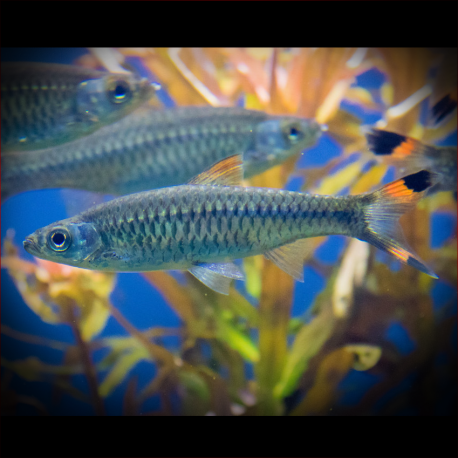More info
Datasheet
| Minimum Tank Size | 319 litres / 84.27 US gallons |
| Maximum Size | 15.2cm / 5.98inches |
| Temperature | 20°C / 68.00°F - 26°C / 78.80°F |
| Hardness | 2-10ºdH |
| pH | 5.0-7.5 |
General Description
The Greater Scissortail Rasbora, scientifically known as Rasbora Caudimaculata, is a peaceful species suitable for larger community aquariums. It is characterized by its striking appearance, distinguished by red-orange coloration in the caudal fin and black tips on the caudal lobes. This species belongs to the Cyprinidae family and can grow up to 15.2cm in size.
Aquarium Setup
The Greater Scissortail Rasbora thrives in well-furnished large tanks with a minimum size of 319 litres. The recommended tank setup includes live and frozen foods such as bloodworm, Daphnia, and Artemia, along with quality dried flakes and granules for optimal coloration and health. Decor choices are flexible, with an emphasis on water quality, open swimming space, and naturalistic elements like plants, driftwood, and rocks.
Behaviour
Known for its gregarious nature, the Greater Scissortail Rasbora prefers to be kept in groups of at least six for better coloration and natural behavior. It exhibits peaceful behavior but can intimidate slower or shyer tank mates due to its size, making it suitable for tanks with bold species like cyprinids, loaches, and cichlids.
Feeding and Diet
This species predominantly feeds on aquatic and terrestrial invertebrates in the wild, with a diet consisting of live and frozen foods such as bloodworms, Daphnia, and Artemia in the aquarium. Regular feeding with a variety of food types helps maintain vibrant colors and overall health.
Reproduction & Dimorphism
Breeding the Greater Scissortail Rasbora in captivity is achievable through egg-scattering and continuous spawning. Females may lay eggs in planted, mature tanks without intervention, but controlled breeding increases fry yield. Adult males exhibit slimmer bodies and faint yellow coloration in the anal fin compared to females.
Habitat and Distribution
Native to Peninsular Malaysia and the Greater Sunda Islands, specifically Borneo and Sumatra, this species thrives in a range of habitats from swift forest streams to sluggish blackwaters characterized by soft, acidic conditions. Adaptable to varying environments, it is found in forested streams with clear or brown-stained water and prefers dimly-lit settings due to canopy coverage.

